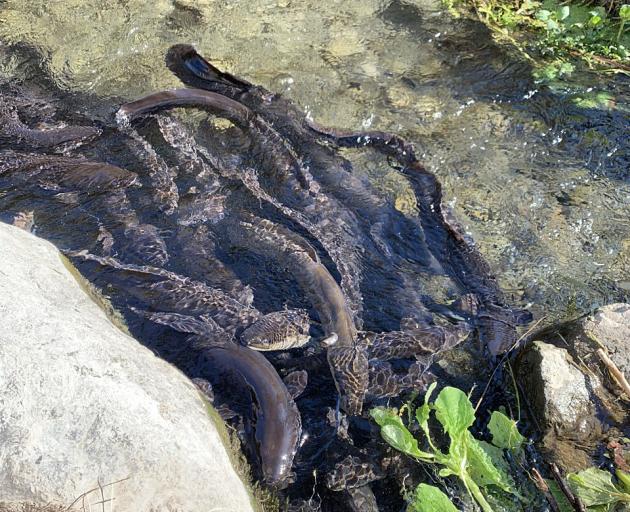
Selwyn District Council is in the process of making up signs to inform people that the eels are protected in Liffey Springs Reserve, Lincoln, and is also advising people not to feed them.
When resident Tamzyn Lea went on her daily lockdown walk with her three daughters early on Wednesday afternoon last week, they stopped at a site regularly visited by locals, where up to more than 20 eels swim up to rocks low on the river bank.
Her daughters were feeding them some vegetables they had taken along when two boys and a girl came to the site.
One of the boys started fishing in the area with a hand reel. She queried what he was doing and advised against it.
The children told her they released any eels they caught, and if one took a hook, they would “rip it out.”
She asked others what they thought of the practice in a Lincoln community Facebook page.
It attracted an outcry from most of the more than 150 commenters who said the eels were tame, almost like pets, and an attraction for families to go and feed.
Some commenters mentioned having seen what was believed to be the same children fishing for eels later that day, with at least one of the creatures caught on the line and being dragged, and another “thrashing” as it was caught.
Lea welcomed the district council’s intention of installing signs at the spot.
However, she did not support its advice that people should not feed the eels, as the creatures were “a massive family attraction.”
Rather the district council could suggest what foods were best for them, she said.
Reserves operations manager Jonathan Crawford said the eels were a nocturnal species, and feeding could encourage them to be active during the day.
In addition, different types of food could lead to them becoming sick.
He said all animals in the district’s reserves, including Liffey Springs Reserve, are protected under the district council’s parks and reserves bylaw.
They are also protected under the Reserves Act 1977.
The district council is hoping to install the signs this spring.
Handling of eels creates welfare issues
Eels can develop life-threatening complications from being hooked or handled roughly, says Willowbank Wildlife Reserve’s managing director.
Michael Willis was responding to reports of children catching and releasing tame eels at Liffey Springs Reserve.
There are two types of native eels in New Zealand – shortfin and longfin.
The Selwyn District Council has identified the eels in the reserve as being members of the longfin species, which only exists in New Zealand and has a conservation status of at risk – declining.
While it is legal to recreationally fish eels, with a bag limit of six per day, this is only outside of reserves and conservation areas where they are protected by the Reserves Act and Conservation Act respectively.

Willis said while many may consider eels to be slimy creatures, in reality their skin felt completely different. Stroking them, which had to be done with wet hands, felt like stroking plush velvet, he said.
Their skin was also a very sensitive organ, and could get damaged easily, from the likes of spears, sticks, hooks or rough handling.
“When this happens fungal infections occur which can be life threatening for them,” he said.
While the official conservation status of longfin eels is in the at risk category, which is below the threatened category, Willis said some researchers considered the species to be just as threatened as the highly endangered great spotted kiwi.
He said some years ago youths broke into Willowbank and killed and wounded some of the reserve’s tame eels.
“They became identified on social media, and the public backlash was severe,” Willis said.
The youths voluntarily went to the police for advice and assistance, but had to close all of their social media outlets for protection.
“Parents especially need to educate their children, as to the beauty and value of a unique and highly threatened species. They certainly deserve a much greater protection status than they currently have,” Willis said.
Department of Conservation senior biodiversity ranger Anita Spencer said eels were fascinating but they were in decline.
She encouraged recreational fishers to consider fishing for other species rather than eels.
New Zealand’s native eels lived for a long time and only bred once at the end of their lives. Longfin eels could live for up to 100 years.
When they were ready to breed, they left New Zealand and swam to the sub-tropical Pacific Ocean to spawn, though the exact location was not known, Spencer said.
Eels were important taonga species to Māori and historically a crucial source of kai.
“The longfin eel in particular faces a range of threats including habitat loss, dams and culverts affecting migration paths, and pollution,” Spencer said.













